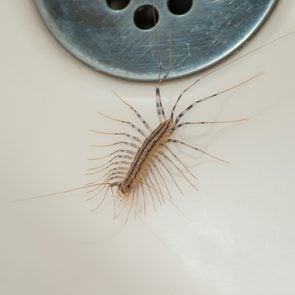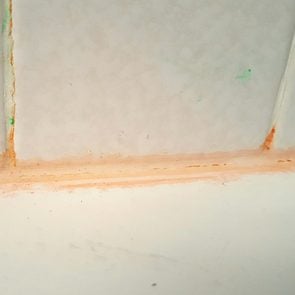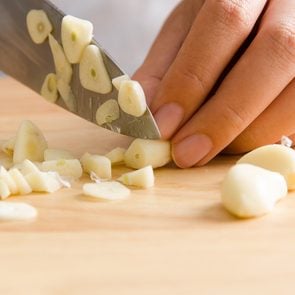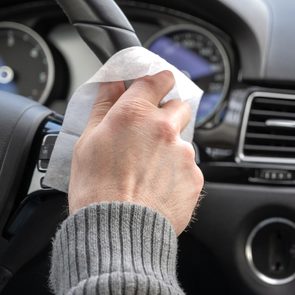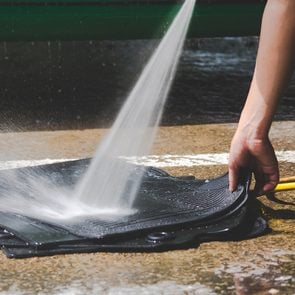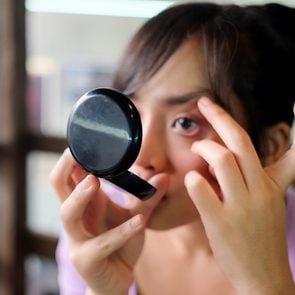Before swatting away one of those pesky “fruit flies” that have been buzzing around your house, you might want to give it a closer inspection. Even if it’s the same size and colour of a fruit fly, pay particular attention to the body shape. If it looks more like a mosquito—and shows no interest in biting—it could be a different flying pest entirely: a fungus gnat.
To the untrained eye, fruit flies and fungus gnats look almost identical. Since it can be hard to differentiate them, Roger Gettig, Director of Horticulture at the Toronto Botanical Garden says the biggest giveaway is in where they’re found. “In general, fungus gnats are going to be near pots of plants, and fruit flies are going to be in your fruits and vegetables out in the kitchen,” he notes.
If you’re itching to get rid of these annoying and invasive critters stat, you’ve already made good progress by identifying them correctly. Next, you’ll need a bit of patience as you work through these eradication strategies that will eventually render your house fungus gnat-free. Here’s how to get rid of fungus gnats in houseplants for good.

Why you’ve got a fungus gnat problem
Fungus gnats generally come from already-infested greenhouse plants, or they can attack outdoor plants and stay in the soil once you bring them inside for the winter. Some sources say they’re attracted to light and sweet scents, but Gettig says they’re primarily attracted to fungus, small roots and decaying organic matter like compost or mulch, all of which are found in over-watered houseplants. Decaying matter provides essential nutrients for hungry fungus gnat larvae, making houseplant soil an optimal breeding ground for the species.
When fungus gnats aren’t laying eggs, though, they’re primarily attracted to moisture, and that’s why you’ll sometimes find them buzzing around damp drains or even open vessels of water. Gettig says adults really only need water to survive, and a small amount at that. “They can drink standing water, even if it’s a drop on your sink,” he says.
In some cases, fungus gnats can even live and reproduce inside the pipes underneath a sink or tub. This usually happens when damp plant soil is unavailable (i.e. the plant owner has stopped over-watering it), and moist pipes—mainly those coated in food residue or other types of decaying organic matter—become the next best option.
Now that you know what they’re attracted to, let’s break down how to get rid of fungus gnats in houseplants.

How to get rid of fungus gnats in their adult stage
Gettig says adult females can lay up to 200 eggs in their life cycle (adults live for about a week to 10 days and the species can survive indoors all year long), which means that at any given time you could have hundreds of fully-grown fungus gnats buzzing around your house. To target the adults, there are a few options.
First, Gettig says stop over-watering your plants—period. “Sometimes people just touch the surface of the pot to see if it needs water, but really you should stick your finger down about an inch.” If the soil an inch deep is still moist, your plant doesn’t need watering. This will help deter fungus gnats because the top layer of soil is usually where they lay their eggs, and if it’s dry, Gettig says they won’t go near it.
Apart from avoiding over-watering, you can also use yellow sticky traps, which are available at most garden centres and home improvement stores. Just lay them on top of your soil or adhere them to a popsicle stick and insert into the soil to trap the adults.
Homemade liquid traps are effective too, says Gettig. All you need is a small bowl, plastic wrap, apple cider vinegar, dish soap and water. Fill the bowl with apple cider vinegar, a bit of water and a couple drops of dish soap and stir gently. Cover the bowl tightly with the plastic wrap (you can use an elastic band to achieve a tighter seal) and use a fork or toothpick to poke small holes in the surface. Whether due to moisture or sweetness of the mixture, the fungus gnats will be drawn to the trap and get stuck under the seal. “Because you’ve added the soap, the surface tension is broken and they will drown,” says Gettig.
Don’t have a green thumb? These hardy plants are virtually indestructible.
How to get rid of fungus gnat larvae
The next step in learning how to get rid of fungus gnats is controlling the eggs. “Even if you killed all the adults, there still could be hundreds or thousands of eggs in your houseplants,” says Gettig. Not only do fungus gnat eggs become annoying adults, but they also evolve into root-eating larvae that could end up leaving your plants susceptible to disease, or even killing them.
While there are a number of different larvae-killing strategies you can try, Gettig recommends starting with a commercial larvicide containing Bacillus thuringiensis israelensis (Bti), which is specifically designed to kill fungus gnat and mosquito larvae. Popular brands include Mosquito Dunks (in puck form) or Mosquito Bits (in pellets).
To apply the larvicide to an infested houseplant, distill a quarter cup of the Mosquito Bits (or broken-up pieces of the Mosquito Dunks) in about four litres of water. Let the mixture soak for six hours and then use it to water your plants. Gettig says it’s best to strain the mixture before using it to ensure none of the bits end up in the soil. (Over time, the Bti will wash out of the pellets and they’ll just become another source of organic matter for the larvae to feed on.) He also advises to use the water within 24 hours, which is when the larvicide will be at peak activation.
After this first application, continue watering your plants normally for about two weeks (letting the soil dry out between waterings of course) and then reassess. How do you know if you’ve gotten all the larvae? Try the trick the use at the Toronto Botanical Garden: just bury a few small slices of potato about a half an inch deep into the soil, and then dig it up a few days later to see if you detect any larvae squirming around in the soil beneath. What you’re looking for are tiny maggot-like creatures with black heads and milky-white bodies. If you see any, you’ll have to repeat the process.
These low-light houseplants thrive in near darkness.
What to do if nothing works
If none of the recommended strategies above seem to be working, there are a few last-ditch efforts you could try. Diatomaceous earth (DE) is a powdered substance you sprinkle onto soil that dehydrates larvae on contact and eventually kills them. Gettig says DE will lose effectiveness upon contact with water though, so you’ll have to apply between waterings when the soil is driest.
Beneficial nematodes are a more costly option, but are worth considering nonetheless. Gettig describes nematodes as microscopic worm-like predators (yes, they’re a living thing), which eliminate fungus gnat larvae by actually crawling inside of them and releasing a deadly bacteria. “They’d have to be shipped to you alive,” he says, which is why they’re more expensive and potentially harder to find. That being said, you might have luck finding them at your local home improvement store depending on stock and availability.
The very last option, according to Gettig, is a systemic insecticide like Bonide, which is absorbed by an infested plant, and then either harms or deters anything that eats the treated plant’s roots or leaves. Problem is, Gettig says it’s toxic to whatever eats it, and the potential risk to pets and even humans makes this his least preferred method and absolutely out of the question on any plants you might consume, like fruits and vegetables.
Need to revive a dead houseplant? These hacks should do the trick.
What doesn’t work
A quick online search of ‘how to get rid of fungus gnats’ will turn up a range of eradication methods, making it difficult to know which to try and which to scroll past. According to Gettig, there are a few specific tricks that aren’t worth your time, starting with neem (a tree that produces medicinal oils). “It doesn’t really work for this type of insect,” Gettig says, because—similar to systemic insecticides—neem oil soaks are absorbed by the plant and only work if the larvae are eating the treated plant’s roots. “There’s so much organic matter in some of these soils that fungus gnat larvae could be not eating roots at all.”
Other purported home remedies like sprinkling cinnamon on the surface of the soil and watering your plants with diluted chamomile tea are ineffective too. “Cinnamon and chamomile tea are natural fungicides, so they could kill off a primary food source,” says Gettig. But again, fungus gnat larvae can survive on roots and other organic matter like peat and bark, so eliminating one food source really isn’t enough to eradicate the species completely.
Drowning—putting your plant in a bucket of water and letting it sit for hours hoping it drowns the larvae—doesn’t work either. Gettig says the studies he’s read show it can kill some—but not all—fungus gnat larvae, so he wouldn’t advise it. The same goes for watering your plants with a diluted hydrogen peroxide and water mixture. “After 30 seconds it’s water and oxygen anyway, so it’s just not super-effective.”
These urban gardening tips are perfect for small spaces.

How to prevent fungus gnats in the future
The best way to prevent another fungus gnat infestation down the road is to check plants thoroughly before you bring them home from a greenhouse. You should do the same with any outdoor plants you might bring inside for the winter, too. Ruffle the plant’s leaves and see if any fungus gnats fly out. If so, you’ll want to avoid taking that plant (and probably others surrounding it) home or bringing it inside.
Gettig also suggests plants from greenhouses or outdoors undergo a quarantine before introducing them to the rest of your houseplants, even if they seem to be fine. “Sometimes it takes a couple weeks before you see something emerge,” he says. Just keep the plant in a different room and monitor it for up to a month to be safe. If you suddenly see fungus gnats flying around, Gettig says to either bag it and remove it from your home or treat it using the methods above.
Now that you know how to get rid of fungus gnats, discover the eight best annual flowers for planter pots.
From frozen pizzas to roast chicken to those fudgy, crowd-pleasing brownies you’ve been making for years, your oven is the common element behind all of your culinary creations. With that in mind, this hard-working appliance could use some TLC every now and then.
There’s lots of regular upkeep you can do to keep the inside of your oven clean, but what happens when you find grease and grime trapped between the oven door’s glass panels?
It turns out you can reach inside the oven door, between the glass, if you follow the steps in the TikTok video below.
How to Clean Inside Your Oven Door Glass
This viral TikTok from @vanesamaro91 is a lifesaver for home cooks. We’ve already learned a lot from the app, like this money-saving laundry detergent hack and this trick for peeling potatoes, but this step-by-step video shows exactly how to clean that tricky spot in your oven’s glass door.
@vaneamaro91#cleaningtiktok #cleaning #oven #ovencleaning #cleantok #satysfying #clean #cleaninghack #clesningtip♬ Blue Blood – Heinz Kiessling & Various Artists
Step 1: Grab a feather duster (or something similar)
This TikTok user recommends purchasing a long microfibre duster. However, she also mentions that improvising with a makeshift duster made from a microfibre towel and a hanger will work just fine!
Step 2: Remove your oven drawer
There should be a storage drawer under your oven that you can easily remove. Once it’s out of the way, there should be a few slots underneath that open directly into the area inside your oven door’s glass window.
Step 3: Grab your go-to cleaning solution
The choice is yours, just spray it on your duster.
Step 4: Clean the glass
Insert the prepped duster into the openings under your oven door. From there, all you have to do is wiggle the duster back and forth until you see sparkling glass!
This TikTok hack will work in a pinch, but for a serious deep clean, Family Handyman explains how to disassemble the oven door.
More Oven Cleaning Hacks
If you’ve finished cleaning the glass in your oven door and are looking for tricks to keep your kitchen tidy, look no further. Whether you want to know how dishwasher tablets can help clean your oven or how to clean a cast iron pan, we’ve got you covered!
Next, Charles the Butler of CTV’s The Marilyn Denis Show reveals how to clean absolutely everything in your kitchen.

I’m the youngest of six children. When I was four, my dad suffered a work accident that left him disabled, so my mom had to take care of him, too. My father’s family wanted to separate us kids into the care of different uncles. But my mom told them no, that she would support us. She had never worked before, but she found a job and was able to keep a roof over our heads, provide food and send us to school.
So even at age four, I had great admiration for my mother’s hard-working attitude. When she got home from work, she would play with us kids outside. We played with a ball, we looked at the sky and the stars, and she always answered our questions. I never heard her say that she was tired; she only wanted to see us happy. I thank my mom because she never gave up. — Marisol Martinez Solano, Mexico City
When I was a self-centred teenager, my mother, Hélène, would tell me that we don’t get points in life for being beautiful or intelligent, because those are traits we are born with. She’d say, “You only get points for being kind, because that is something you have to work at and choose to be.” I needed to hear that. — Lise D’Amours, Casselman, Ontario
My mom was the most generous, loving person. If she knew of someone who was sick or dealing with hard times, she immediately prepared food for them. Now I do the same for my loved ones. My brother just went into surgery, and I made the family meals to get them through the week. It brings me so much joy to know that I’m helping (and it doesn’t hurt that I love to cook). — Barb Kniel, St. Albert, Alberta
Mom taught me that everyone has something that drives them. She always said, “If you’re passionate about something, go for it and give it your all!” When she got tired of having a boss, she started her own business. And when she had to close her business, she tried something else she was passionate about. She taught me the importance of having priorities.
I don’t like my current job. Like my mother, my priorities are my family, my partner and my close friends. So I keep my eyes open, waiting for the opportunity to find the job that fulfills me. — Maude, Abbeville, France
My mother taught me to forgive and forget. That we shouldn’t dwell on past grievances, but that instead we should let go of them and move on. My mother and I joked, later in life, that in earlier years we didn’t always remember that lesson! But on her deathbed, we forgave each other for being human, one last time. That, l won’t forget. — Eleanor Holwerda, Victoria, B.C.
A few weeks before I married by husband, my mother took me aside and gave me some advice. Mum and Dad were married for 42 years and had four children. Throughout their marriage, they faced the many challenges that raising a family, juggling finances and having unexpected poor health presented.
Still, Mum is a straight shooter, so I was a little apprehensive as I followed her down the hallway of our family home and into her bedroom that day. After closing the door, she launched into the importance of being sure of the big commitment I was about to make.
Her closing advice left a strong impression on me: “You know, marriage isn’t one relationship, it’s a series of them,” she said. “Be prepared for things to change between you both. As new challenges arise, you’ll find that you both change. But if you work together, you’ll end up with a better relationship.”
This was the best wedding advice—and life lesson—I could have hoped for. And after 24 years of marriage, we’re still going strong, warts and all! — Louise Waterson, Sydney, Australia
My mom, “Bunny,” would tell it like it is. But she had the wisdom to hold her tongue if saying something would not be helpful. She would tell me: “If you don’t have something nice to say, keep your mouth shut.” I have heard these words echo in my mind on many occasions, and they have often prevented me from escalating issues. — Steve Lewis, Redbridge, Ontario

In addition to the many beautiful and uplifting things my mother taught me, I learned the importance of letting go once your children reach an age when they want to find their way and stand on their own two feet.
Of course, a mother will always see a son or daughter as her child, but we must have the courage to let this child leave the nest when the time comes. This does not mean we stop loving them, but we also show them that we believe in them, that they are strong, and that we stand behind them, no matter where life takes them. — A.K., Zurich, Switzerland
My mother passed on a whole world to me. She had studied piano and played regularly at home, bringing the essence of classical music to my young ears. We had an upright piano in the dining room, and I would sit on a stool next to her and watch her play Bach’s “The Well-Tempered Clavier,” sonatas by Mozart and Beethoven or Debussy’s “Gardens in the Rain.” I was fascinated. I started playing the violin when I was seven, and my siblings and I sometimes played together.
Today, I enjoy going to concerts, reading about great composers (I’m currently on Schubert) and I’m taking music-history courses.
My mother gave me such a beautiful gift. The older I get, the more I’m moved by music’s infinite richness. — Vincent Philippe, Paris, France

To speak of my mother, Remedios, is to speak of unconditional and infinite love. She was born in the 1930s, a few months after the outbreak of the Spanish Civil War, and grew up during the harsh postwar period.
She was extraordinarily resourceful and created a happy and welcoming home for her family and friends. But her affection was always accompanied by the knowledge that to love well, you have to know how to say no to your kids.
I don’t remember my mother ever being idle; the only time she sat down was to sew, an activity that became an extra source of income for the family. Also from her blessed hands came magical casseroles and healing caresses.
Her unconditional devotion multiplied when she became a grandmother. Today, her legacy of love lives on in each of us. — Mercedes Dominguez, Madrid, Spain
Mothers are the greatest gift in the world. My mom is no exception. She made sure we got a university education, and she worked different jobs to help my dad with the household expenses. She never complained about how hard it was.
Now that I am also a mother, I realize how important a mother’s role is: A foundation of the home, the light of the family, the nurturer of children and an inspiration to others. My mom taught me that mothers are very special gifts from God—gifts that can never be bought and are always available. — Maricarl Garcia, Manila, Philippines
My father’s death pulled the rug out from under my mother, in part because she had no other close relationships aside from him, my sister and me. Her life revolved around her family. From that experience, I have learned that it is important to focus not only on family, but also to build a broad emotional base with friendships. This gives me support and resilience when life is more difficult. — Dominique Graf, Zurich, Switzerland

My mother taught me so much about life, both intentionally and by example. Having had six children, she was very busy trying to make ends meet in the 1950s and ’60s. We were fortunate to have some land, and my mom taught me how to be as self-sufficient as possible by canning, curing, freezing and preserving our own food. She also taught me to be more patient, compassionate and empathetic.
From my mother, I learned one of my most valuable life lessons: that we have the power to make our own lives happier, healthier and more meaningful than we realize. — Debbie Browne, Spruce Grove, Alberta
Being around my mother is like never leaving school. Dona Glaucia is an endless source of knowledge. Throughout my 30 years of life so far, this independent woman has showed me how to live with my head held high, to own my choices and not to linger over the difficulties but do what needs to be done.
Thanks to her, I learned that a suburban Black man has the right to dream and the duty to make that dream come true.
My mom, who is a nurse, always makes time for me—she finishes a chaotic shift and still finds the energy to ask me about my day, and she truly listens. She is always giving the best version of herself. — Walter Farias, Rio de Janeiro, Brazil
My mom’s greatest lesson to me is that kindness never gets old or boring. Whether it is a smile for a stranger, holding a door open for someone or giving to a charitable cause, the rewards for making even a small difference seem endless. — Tammy Alagierski, Mississauga, Ontario
My mother had some funny yet wise suggestions when it came to finding a partner, such as, “If you want to meet a man, walk around the hardware store. You might meet a nice and handy man.” And: “If you see an attractive man, go up to him. Don’t wait for a man to come to you. You might wait a long time.”
Other gems of advice she shared:
- “Never wear elasticized pants. To stay slim, be aware of your waistline.”
- “A cup of tea enjoyed alone or with a friend is therapeutic and soothing.”
- “Always get ahead of constipation; deal with it before it becomes chronic.”
Above all, she taught me to be kind, especially in marriage and toward those who need it the most. — Joan McCann, Toronto
If you enjoyed these life lessons from mom, don’t miss our roundup of fascinating facts about Mother’s Day in Canada.
You probably have a weekly cleaning routine for your home. Heck, you probably even make sure to hit the car wash the minute the outside of your car starts looking worse for the wear. But when was the last time you actually cleaned your car interior?
Unlike at home, your dirty shoes are almost always on in the car, and there’s a good chance you’ve been caught snacking during the rush to get to your next destination. All that use makes for a pretty grimy car interior, but most people don’t bother cleaning as often as they should.
To keep the inside of your car sparkling, you should be cleaning it at least once a month, Christian Newman, owner of C & J Automotive Detailing tells TODAY. And if the dog hair and granola bar crumbs start building up even sooner, you might want to clean the inside of your vehicle every other week. In other words, there’s a good chance you need to clean yours more. Luckily, we’ve got the steps you need to get the job done.
How to Clean Inside of Your Car
Start with a vacuum—but not where you think
Don’t start by vacuuming the carpet when cleaning your car interior; you’ll just end up pushing dirt back on when you clean the seats and other areas. Instead, start by attacking the dashboard, door panels, and console with your vacuum.
Open the door
Now take a look at the door jamb, the area where your car door connects to the body of the car. “Door jambs are one of the first parts of a car you see when you get in, so keep them clean,” Newman tells TODAY. By using a cotton cloth to rub mild polish into the area, you’ll not only make the area look nicer, but also add oils to keep it from getting too dry.
Wipe down the vinyl
To get dust and dirt off your dashboard and door insides, start by wiping the vinyl with a rag, suggests auto repair company Your Mechanic. Then spritz a microfibre cloth with vinyl cleaner and wipe down the surface, getting rid of the excess with a dry cloth. Just avoid the steering wheel, because vinyl cleaner can make it slippery and hard to hold onto. Don’t forget to hit the pockets in your door by de-cluttering and vacuuming.
Wash your windows
When you roll down your windows, you might notice a buildup of dirt toward the top—don’t forget to hit those edges when you wipe down your windows and mirrors, suggests Family Handyman. (Here’s more advice on how to clean car windows.)
Scrub those seats
Before washing seats, get the dirt off with a vacuum. Next, for cloth seats, work at a spray-on cleaner with a scrub brush. If your seats are leather or vinyl, use a lotion-based leather cleaner, which can work on either material, Newman tells TODAY.
Hit the floor
Finally, it’s time for the floors. Start by removing the mats and sliding your seats forward—junk tends to build up behind them. Go over the mats and carpet with a brush-free attachment, and use these tips to remove salt stains as required.
Now that you know how to clean inside of your car, check out the car cleaning tricks pro washers don’t want you to know.
If you tend to fill your car’s gas tank until it’s full, rather than paying for a specific amount of gas, you’re very familiar with the thud that the gas pump makes when it shuts off. Once you hear that, you know your tank is full, and you can stop filling up.
But how does that work? How does the gas pump “know” the tank is full? If anything, you’d think it would be a gauge on your car, not the unattached pump, that would fill you in (pun not intended).
Well, it has to do with the way the gas pump works. When you fill your tank with gas, you’re replacing the air that’s in there. “The more gas goes in, the more air must come out,” explains Jake McKenzie, Content Manager at Auto Accessories Garage. “It comes out through a small pipe located just inside the gas nozzle.”
And pressure has built up in the tank; that pressure is released as the air escapes. McKenzie compares it to holding your thumb over a garden hose: “Blocking part of the hose [increases] the pressure of the water inside, [causing] the water leaving to spray out at an even greater velocity.” When you start to pump gas, the pipe, which has been “blocked” like the hose, releases the air quickly. “This expelled air brings with it a pressure that’s strong enough to hold the valve in the open position,” McKenzie says.
So that’s what happens while you’re filling up your tank. And once it’s full of gas, gasoline, not air, now reaches the pipe inside the nozzle, which evens out the pressure. As McKenzie explains, this creates “a small suctioning force (known as the Venturi effect) that switches the valve to the off position.”
So that’s how you know to stop putting gas into your car!
Now that you know how gas pumps know when to stop, find out why all cars don’t have gas tanks on the same side.
If all this talk about ChatGPT has left you with a confused look on your face, you’re not alone. After all, it could be the biggest innovation we’ve seen in the world of tech over the past decade or so—and quite frankly, it may change every other industry, too, including how we learn, work, shop and create.
What is ChatGPT?
Launched in late November 2022 by the San Francisco-based OpenAI—but already used by more than 100-million people by January 2023—ChatGPT is a “generative A.I.” (artificial intelligence) computer program you can chat with online.
That is, type in a question or comment, and within a second, ChatGPT will begin interacting with you in a human-like manner. To try it for yourself, you can create an account and access ChatGPT for free here.
Unlike your Google or Alexa smart speaker, this is conversational A.I., so you can go back and forth with ChatGPT (via text, not voice—for now) as if you were interacting with a real person. This interaction is made possible through ChatGPT’s “natural language processing”: extensive training on a dataset of human language, pulled from several million books, documents, news articles, scientific journals, and the web (mostly Wikipedia). The result? ChatGPT not only understands what you’re typing, but responds quickly, articulately, and (mostly) accurately.
This is where things get exciting—and a little scary, too.
What Can ChatGPT Do?
Before we talk about some issues with the technology, a few practical things you can do with ChatGPT:
It can write for you
Tell ChatGPT what you’re writing about and it will generate the content, whether it’s a speech for your best friend’s wedding, a news article (yes, journalists like yours truly might be concerned), a school essay, a poem, or a song, complete with accompanying chords to play on piano or guitar.
With essays, you can specify the length (100 words? A thousand?), and even the particular style. I asked ChatGPT to explain quantum computing as Homer Simpson, for example, and it kicked off with the following:
Okay, so imagine you’re Homer Simpson, right? And you’ve got a donut, and you want to eat it. But instead of just taking a bite like a regular person, you decide to take a bite out of every possible combination of the donut at the same time. That’s kind of like what quantum computing does! It uses these tiny, tiny particles called “quantum bits” or “qubits” instead of regular bits like in your computer. And because of the weird rules of quantum physics, these qubits can exist in multiple states at the same time.
It can provide professional support
ChatGPT can be used in several ways to advance your career. If you’re looking for employment, ChatGPT can help you with the job search and interview prep, and even provide career advice. Considering a side hustle? Ask ChatGPT to create a business plan, and suggest some good names for you to use. (When I told ChatGPT I had an idea for an app that lets people buy and sell second-hand tech, it spat out seven good app names, each with a brief description!) If you’re prepping a presentation to deliver to your colleagues, ChatGPT can summarize research for you, including entire reports, so you look like a rockstar in the boardroom. And if you’re late for work one day, just ask ChatGPT to write a good email apology to the boss.
Learn another language, even programming code
Travelling to Europe this summer? Give ChatGPT the phrases you want to learn to get around, and it can translate them into nearly 100 different languages—instantaneously.
And much more
There have been many published instances of ChatGPT being used for relationship advice, assisting with travel plans (“If I have three days in Quebec City, what should I do?”), and creating a five-course meal for vegetarian guests, just to name a few.
Concerns Over ChatGPT and Other “Generative A.I.” Tools
Like any brand-new technology, there are legitimate concerns over “automation” replacing human jobs, whether it’s A.I., robots or autonomous vehicles. Educators are understandably concerned about plagiarism among students. And while it’s improving—ChatGPT 4 (launched in March) is more accurate than its predecessor, ChatGPT 3.5— there are still some inaccuracies.
As reported by CNBC, ChatGPT incorrectly analyzed earnings reports for Lululemon. It also once said I was a television actor. I’m on television, yes, but as a technology analyst.
Tech experts say ChatGPT makes mistakes due to conflicting information in its vast database, but will be corrected over time (sort of like how a communal platform like Wikipedia gets more accurate the more people use and edit it). Also note, the previous version of ChatGPT was limited to info up until 2021 (therefore, it didn’t know anything about the Russian-Ukrainian war, for instance), but has since been updated with ChatGPT 4.
South of the border, some Republicans claim ChatGPT has an anti-conservative bias, citing its alleged refusal to write poem about Donald Trump’s “positive attributes.”
Some tech luminaries, including Elon Musk, have suggested A.I. advancements are happening too quickly, and should be paused until they can be better understood and regulated. In April, ChatGPT was banned in Italy, due to concerns regarding its possible negative impact on society.
For the time being, I consider ChatGPT a tool, and a fascinating one at that. Like any innovation, it could be used or abused by the humans who rely on it.

Where Does ChatGPT Go From Here?
Microsoft, which invested $10 billion USD into OpenAI in February, is weaving ChatGPT capabilities into its Bing search engine, just as Google is readying its answer to ChatGPT, called Bard.
Soon, Canadians can expect smart A.I. to help with online searches, such as cleverly summarizing the information you’re looking for (without requiring you to visit websites appearing in the search results), allowing you to converse with the platform like a person, and creating A.I.-generated imagery, such as requesting a photo of “a woman on the street, talking on her smartphone” that you may want to use on your website. Cool, no?
As for the existing ChatGPT, there is a paid version, too, dubbed ChatGPT Pro. For around $20 a month, Pro includes extra features, access to the chatbot even during peak usage periods, faster response times, and early access to improvements.
Based in Toronto, Marc Saltzman has been “breaking down geek speak into street speak” for more than 25 years. Follow Marc on Twitter for his “Tech Tip of the Day” posts, or subscribe to his Tech It Out podcast.
Next, find out how Canada’s 3G network shutdown could affect you.
An engine can seize due to running on low/no oil, overheating or succumbing to a broken timing belt. These conditions eventually stop your engine in its tracks and a professional technician will be required to restore function. However, if an engine seizes due to rusted cylinder walls, you can restart the engine without professional help.
This is how rusted cylinder walls develop: When a vehicle sits for an extended period of time without running, the lubricant coating the cylinder walls thins and drains away due to gravity. Shutting down a vehicle always leaves some of the intake valves open on some of the cylinders. This allows moisture-laden air from the environment to circulate through the engine’s air intake, progress through to the cylinder head, and cause condensation on the cylinder walls, piston surface and rings.
Left long enough, that condensation causes rust that can freeze the pistons in place, causing a seized engine. If you suspect that this is the case for your vehicle, this is how to fix a seized engine.
What you’ll need to fix a seized engine:
- Breaker bar
- Combination wrench set
- Screwdrivers (Phillips and standard)
- Socket set (Here are more tools every home mechanic needs.)
- Gasket sealant
- Masking tape and a pen
- Penetrating oil
- Replacement gaskets
How to fix a seized engine: Step by step instructions
Step 1: Disconnect accessories
The crankshaft drives many parts located outside of the engine block. Disconnect any belt-driven accessories and parts under the hood. These parts, such as the alternator, water pump and power steering pump, increase drag on the crankshaft. Disconnecting them reduces the power needed to dislodge the pistons and allow the crankshaft to turn.
Step 2: Equalize pressure
Use a socket to remove the spark plugs, taking care to number the wires as each is disconnected. You will need to reconnect each wire to its original cylinder when putting everything back together to keep the timing in sync. Removing the plugs releases any pressure within the engine that could push against you as you work to free the pistons.
Step 3: Remove the valve covers
Use a wrench to loosen the restraining bolts holding the valve cover in place on each cylinder head. Remove the covers to expose the rocker arms. Next, remove the nut holding each rocker arm in place and remove the rocker arms. Pull the exposed push rods out of the cylinder head. This step also reduces the resistance you must overcome to turn the crankshaft manually.
Step 4: Turn the crankshaft
Locate the front of the engine block. On a transverse engine, this will be to one side or the other. At the front, you will find either a round harmonic balancer or a pulley that drives a belt. In either case, at the centre will be a bolt head. To this bolt, attach a socket fitted onto a long-handled breaker bar.
Turn the bolt in a clockwise direction to free the engine. If you cannot get the engine to turn, apply penetrating oil to the walls of each cylinder through the spark plug wells. Give the oil a couple of hours to work its way past the piston rings and try again. This process may require several applications over several days.
If the car is equipped with a manual transmission, you can put the car in gear and rock it back and forth using the momentum to rotate the engine.
Step 5: Reassemble
Once the engine is freed, work backward to reassemble the engine, replacing any seals or gaskets uncovered in the process of opening things up. Make sure the battery has a charge, then try to start the engine.
If you can’t get the engine to turn, the damage may exceed simple cylinder rust and you will need to make a decision on whether an overhaul is worth the effort to save the vehicle.
Next, find out more tricks to try when your car won’t start.
After the pandemic hit in 2020, Nida Shahzeb, a 38-year-old social-media specialist in Mississauga, was busier than ever—working from home while looking after her three children, aged 11, eight and five. When spring arrived, they spent as much time as they could playing in their backyard, where Shahzeb was planting a garden.
One evening in June, Shahzeb briefly closed her right eye while using her iPad. When she did, she noticed something odd about the vision in her left eye.
“The screen was hazy and shadowy,” she recalls. She assumed her eye was tired, but the next morning, the problem was still there: greyed-out spots in her central vision. The eye wasn’t sore or red, but after a couple of days she listened to her gut—and her GP—and headed to the emergency room.
The ER physician who examined her was mystified. He gave her an urgent referral to an ophthalmologist, who would have more expertise. Shahzeb went immediately.
Looking for answers
After dilating her pupil, the doctor spotted inflammation in the retina and suspected Shahzeb had white dot syndrome—a category of eye disease characterized by lesions deep in the retina—but couldn’t determine any reason why. She told Shahzeb that she needed to see a specialist in diseases of the retina—and quickly.
By now, Shahzeb was frantically reading everything she could find online about eye diseases. “All day long I was worried about it,” she says.
The next day, she visited Dr. Netan Choudhry, medical director at Vitreous Retina Macula Specialists of Toronto. Choudhry explains the urgency: “When you’re experiencing a vision lapse and you don’t know why, you need to make a move. There’s a concern it’s rapidly progressive.”
White dot syndrome has a variety of suspected causes, including viruses, autoimmune disease, even lymphoma, and while some conditions improve on their own, others can result in permanent vision loss without treatment.
If you show any of these symptoms, you need to see an eye doctor.
Was it just an inflamed retina?
Using optical coherence tomography, which applies light like an ultrasound to take high-resolution images of the retina, the medical team determined that Shahzeb’s macula—the critically important central area of the retina—was inflamed. Since Shahzeb was young and healthy, a likely trigger was a virus, in which case she just needed a course of steroids to settle the inflammation. Choudhry prescribed the medication and told Shahzeb he’d recheck her in a few days.
In the meantime, Shahzeb struggled to focus on the computer screen. She stopped wearing her glasses, which exacerbated the problem. It seemed her vision was deteriorating further, but she recognized that might have been her feeling anxious. “It could have been my brain messing with me!” she says.
After a few days, she returned to Choudhry’s office. This time, the testing was even more extensive. One potential cause was a tiny parasite, but if indeed that was the cause, it was well hidden. The team used multi-spectral imaging, which shines lights of different wavelengths, allowing doctors to see deep layers of the retina.
An unexpected finding
When Choudhry reviewed the images, he instantly realized they’d found what they were looking for. There, on the macula, was a pale squiggle less than 2.5 millimetres in length. It was a roundworm. And since it changed positions between images, it was obviously alive.
For weeks, the parasite had been tunnelling, undetected, through Shahzeb’s macula. “It’s like a bulldozer moving through a forest. As it moves, it destroys,” says Choudhry.
Several species of tiny worms have been known to invade the human eye, although it’s rare, and in up to three-quarters of cases, the culprit isn’t visible on imaging tests. But one of the most common species, a roundworm called Baylisascaris procyonis, is also one of the largest and most devastating.
Choudhry had previously asked Shahzeb about contact with raccoons and cats—both can occasionally transmit Baylisascaris to humans—but Shahzeb had brushed it aside. Questioned again, though, Shahzeb recalled disposing of raccoon feces she’d found in her backyard garden, about a month before her symptoms had appeared. She used gloves for the job, but Choudhry says that wouldn’t have prevented a Baylisascaris egg from entering Shahzeb’s body through her respiratory system.
Shahzeb held her emotions in check until she got to the car, where she broke down and cried as her husband pressed her to tell him what was wrong.
Treatment options were dwindling
As long as the worm stayed near the surface of the retina, it could probably be removed. Choudhry arranged for Shahzeb to see Dr. Efrem Mandelcorn at Toronto Western Hospital the next day. But new scans showed that the parasite had burrowed deeper in just 12 hours. Removal was no longer an option without damaging Shahzeb’s eye.
Mandelcorn had no choice but to kill the worm by overheating the area with a thermal-laser instrument and leave it in the eye. Its body would eventually disintegrate, but its species would never be known for certain. Three days later, at a follow-up appointment with Choudhry, Shahzeb was relieved to learn the worm was no longer moving.
Shahzeb still has blotted-out areas in her central vision, but as her brain has adapted, it has learned to fill in some of the gaps, and she doesn’t notice the loss as much. There’s also a chance some cells will regenerate over time.
“I like to think my colleagues and I unravelled the mystery in time to rescue some vision,” says Choudhry. “If this had been left for months or longer, it could have gotten to the point where she saw no light at all.”
That gives Shahzeb goosebumps. “I’m just so grateful this was discovered and that I didn’t end up losing my eyesight to the point where I couldn’t function,” she says. There’s one activity, however, she won’t resume. “My mom said, ‘Don’t even think about going back in the garden!’”
Next, read the incredible story of how a woman’s X-ray revealed the reason behind her life-long stomach pain.
As kids growing up in Sapawe, a sawmill town of 200 people in northwestern Ontario, my brother Randy (or Rand as I called him) and I were constantly roaming the forests and gravel roads around town in search of new outdoor adventures. The following is one such story from our childhood.
On the Hunt
One spring, when I was ten and Rand, 11, we decided that our lives would be greatly enriched if we could keep a young raven as a pet. We hatched this idea after we read a book we’d borrowed from the bookmobile extolling the intelligence of the crow family. A raven, a member of the crow family, would certainly be a superior pet indeed. A young bird made the best pet, the book said.
This being late April, a time when young ravens were almost fully fledged, it would be the perfect time of year to capture our unwitting pet. And we knew just where to find a nest full of ravens. A few miles north of town on a logging road appropriately named the North Road, there was an abandoned open- pit mine. The mine itself was a giant gaping hole that had been blasted into the top of a ridge. It was on the vertical rock face of this pit that a pair of ravens nested each year. The time of year was right, the raven nest had been located, now all we would have to do was find a way to coax a young raven out if its inaccessible nest and into our waiting arms.
When the weekend came, Rand and I jumped on our bikes and headed for the mine. We never thought to bring any equipment with us, save for our optimistic young minds which seemed to be all the tools we’d need. An hour later, we reached the spot where the open-pit mine was located. The mine was just a bit off of the road, so we ditched our bikes and picked our way over the snow hummocks, remnants of a slowly retreating winter.
The rim of the open-pit mine was located on the ridge above us and since that was the best place to view the raven nest, we had a bit of climbing to do. Up the slope of the ridge we scrambled, pulling ourselves along by grabbing skinny trees and clambering on all fours. As we crested the ridge top, we stood and stared into the huge gaping hole. Across the abyss was the raven’s nest, situated about halfway down the vertical rock face. As we’d hoped, the nest was full of large fledgling ravens.
So, this was our plan: We would toss stones across the pit which would clatter noisily off of the rock wall where the raven nest was located, and the noise would frighten one of the young ravens enough that it would take its first flight from the nest to the floor of the pit.
As the adult ravens circled above us, croaking their displeasure, my brother and I searched the frozen ridge top for rocks big enough to throw. Fifty thrown rocks later, our plan worked. A young raven jumped out of the nest and laboriously flapped the length of the open-pit mine, making a controlled descent the whole way. We cheered as we watched the bird land on the floor of the crater below.
Scrambling and rolling down the slope of the ridge, we headed for the large opening that was the road-level entryway into the pit. We had never walked on the mine floor before, so we crept forward carefully through scrubby trees and large boulders, our eyes searching for the young raven. The raven was a bit nervous at our approach but soon Rand had his coat wrapped around the bird’s body, effectively subduing its flapping wings. We left the bird’s head and tail uncovered and headed for the mine’s exit.
Second Thoughts
Back on the road, Rand handed the huge wrapped bird to me while he climbed onto his bike. I then handed the bird back to him, which he tried to tuck under one arm while holding the handlebar with his other hand. Brimming with our success, we began to pedal back home.
Our elation was short-lived. We’d only gone a short distance, Rand wobbling slowly along on his bicycle with the raven under one arm, when almost in unison we reached the same conclusion. Without the haranguing of a parent and with only our internal sense of self-governance as a guide, we realized that a bird of this size was not going to be a suitable pet.
So back over the snowy hummocks we went, the raven still wrapped in Rand’s coat. We re-entered the mine pit, unwrapped the bird and placed it as high in a young spruce tree as we could reach. Though it was now out of the nest, we felt confident that its parent would continue to minister to the young bird’s needs in this new location.
We never mentioned our raven quest at the open-pit mine to our parents, but thinking back on this and some other adventures that my brother and I had, I asked my mother later in life if she ever worried about what we were up to when we were off on our outings. Her reply was that with two younger children at home to attend to, it was impossible for her to give all her attention to us. But it was what she added to that sentence that surprised me: “I thought that if the two of you were off together and something happened, at least one of you would make it back home to let us know.”
In conclusion, considering the dangers we courted on that outing, I should finish with this sage advice: “Don’t try this at home.” More to the point, I would suggest that you not make an open-pit mine your playground!
Next, find out what it was like growing up in an Eaton’s catalogue mail-order house.
Have you ever wondered why one specific type of produce, the English cucumber, is packaged differently from almost every other fruit or vegetable in a grocery store? Or why these coddled cukes can cost four times as much as their counterparts? There’s a good reason for it, and once you’re in the know, you might change which variety you reach for in the produce aisle.

What is an English Cucumber?
English cucumbers are sweet, slender, straight and have fewer, less noticeable seeds than many other cucumbers. You’ll also see them called greenhouse cucumbers, hot house cucumbers, European cucumbers and seedless cucumbers.
English cucumbers are about a 14 inches (35 centimetres) long and about 1-1/2 to 2 inches (4 to 5 centimetres) in diameter. They’re grown off the ground, hanging or on a trellis, to get their characteristic shape. They’re also self-pollinating, which allows them to be grown indoors in greenhouses because they don’t need bees, animals or wind to help them produce seeds and fruit.
English Cucumber vs Cucumber
The American slicing cucumber is your standard field cucumber in North America. Compared to an English cucumber, its skin is darker and thicker and its seeds are larger and more plentiful. It’s usually a few inches shorter and may be closer to 2-1/2 inches (5 centimetres) in diameter. It’s a plumper, sturdier fruit.
An American cucumber tends to have smoother skin, while an English cuke’s skin may be more furrowed. However, you don’t need to peel or seed an English cucumber, whereas you’ll usually want to take these extra steps with a field cucumber to improve the flavour and texture of your dish. These differences help explain why it can be worthwhile to pay more for an English cucumber, especially if you’re highlighting the ingredient in cucumber recipes like tea sandwiches.
Some people also find field cucumbers hard to digest, hence the term “burpless” for English cucumbers.

Why Are English Cucumbers Wrapped in Plastic?
The quickest way to identify an English cucumber at the grocery store is by its shrink wrap. These thin-skinned fruits need the extra protection of plastic so they don’t get bruised or dried out in transit. Tender skin is one of the reasons English cucumbers are less bitter than other varieties. And the plastic is in lieu of the wax coating you’ll often find on field cukes.
Next, find out why maple syrup bottles have those tiny handles.




